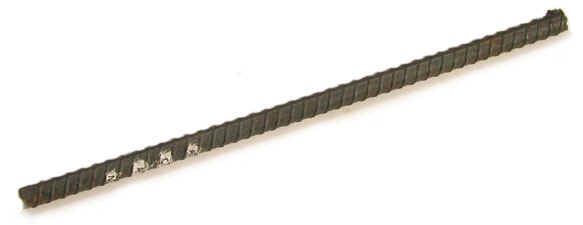Contaminated Rebar from Juarez

Sometime in November, 1983, Sotelo and Ricardo Hernandez removed a Picker C-3000 teletherapy unit from a hospital warehouse in Juarez, Mexico and loaded it onto their pickup. For one reason or another, the source capsule was perforated and approximately 1,000 pellets (each consisting of 70 mCi of Co-60) fell into the bed of the truck. They then took the teletherapy unit to a local scrapyard and sold it for $10. Afterwards they drove the truck to Aldama Street and parked it. The battery died and the truck remained at that location for the next seven weeks. During this time it was common for people to hang around the truck engaged in conversation. Sotelo’s children even had a tea party inside. Exposure rates near some parts of the truck were quite high, e.g., the exposure rate at three feet from the driver’s side of the cab was 50 R/h.

At the scrapyard, many of the cobalt pellets that had remained in the source capsule were scattered around when the teletherapy unit was dropped by a magnetic crane. The rest of the pellets stuck to the magnet and became mixed with steel leaving the scrapyard. Most of the latter went to two local foundries. One foundry melted down the steel to produce the pedestal-style table legs used in fast food restaurants. The other produced steel rods (re-bar) for reinforcing concrete.
The problem was discovered when a truck carrying the reinforcing rods made a wrong turn at Los Alamos and set off a radiation alarm. Within three days the two foundries had been identified as the source of the contaminated table legs and re-bar, and the scrapyard and contaminated pick-up truck had been located.
Estimates place the radiation exposure of at least four people in the range of several hundred rad. Two workers at the contaminated scrapyard became sterile, possibly permanently. No one died. The major concern is increased risk of cancer among the exposed individuals.
The following information is taken from the NRC Inspection Manual, Manual Chapter 1302 Action Levels for Radiation Exposures and Contamination Associated with Materials Events Involving Members of the Public:
"On January 17, 1984, Region IV was informed that Los Alamos National Laboratory (LANL) had detected some radioactive reinforcing bars (rebar) in a shipment mistakenly delivered to LANL. The rebar was determined to have been inadvertently contaminated with cobalt-60 (Co-60) and that the shipment had come from a supplier in Mexico through a broker in Phoenix, Arizona.
Guidance on dose levels for members of the public who might occupy structures containing the contaminated rebar was established by the Office of Nuclear Material Safety and Safeguards (NMSS). Because the exposure to Co-60 was considered similar to Ra-226, the guidance in 40 CFR Part 192 was selected as a basis for remedial action. Remedial action, for gamma radiation in buildings, is addressed in 40 CFR 192.12 (b)(2). This section, in part, requires that the: "level of gamma radiation shall not exceed the background level by more than 20 microroentgens per hour." Using this as a reference point and an occupancy factor of 0.75, the total exposure is within 1.3 mGy/yr (130 mrad/yr). The NRC guidance also noted that the 1.3 mGy/yr (130 mrad/yr) level: "should, in most circumstances, maintain doses within 5 mSv/yr (500 mrem/yr) from all sources of radiation as recommended by the ICRP and, considering the 5.3 year half-life of Co-60 contamination, will not likely cause the average annual lifetime dose to exceed 1 mGy (100 mrad)."
Related Notes. Because of the implementation of the revised 10 CFR Part 20 (effective January 1, 1994), however, the NMSS recommended guidance for situations of this type in the future is to limit exposures to within 1 mSv (100 mrem) per year."
Donated by the Arizona Radiation Regulatory Agency courtesy of Paul Harvey.
